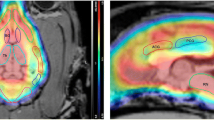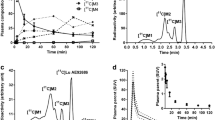Abstract.
Accurate quantification of neuroreceptors requires full kinetic modeling of the dynamic single-photon emission tomography (SPET) or positron emission tomography (PET) images, with highly invasive arterial blood sampling. This study investigated the application of a reference region kinetic model to the dynamics of [99mTc]TRODAT-1 in nonhuman primates, obviating the need for blood sampling. A series of dynamic SPET scans were performed on two baboons following the injection of approximately 700 MBq of [99mTc]TRODAT-1. Rapid arterial blood samples were taken automatically during scanning. Reconstructed SPET images were co-registered with magnetic resonance imaging (MRI) scans of the baboons, and regions of interest (ROIs) placed on the striatum, cerebellum and cerebral hemispheres. The ROI data were combined with metabolite-corrected blood data, and fitted to a three-compartment kinetic model using nonlinear least squares techniques. The same data were also used in a simplified reference region model, in which the input function was derived from the nondisplaceable tissue compartment. In addition, semiquantitative blinded analysis was performed by three raters to determine the point of transient equilibrium in the specific binding curves. All methods generated values for the ratio of the kinetic rate constants k 3 /k 4, which gives an estimate of the binding potential, BP. These were compared with the full kinetic model. The mean values of k 3 /k 4 for the three different analysis techniques for each baboon were: 1.17±0.21 and 1.12±0.13 (full kinetic model), 0.93±0.13 and 0.90±0.07 (reference region model), and 0.97±0.18 and 0.92±0.08 (equilibrium method). The reference region method gave significantly lower results than the full kinetic model (P = 0.01), but it also produced a much smaller spread and better quality fits to the kinetic data. The reference region model results for k 3 /k 4 correlated very strongly with the full kinetic analysis (r 2 = 0.992, P<0.001), and with the equilibrium model (r 2 = 0.88, P = 0.002). The subjectivity inherent in the equilibrium method produces inferior results compared with both kinetic analyses. It is suggested that the self-consistency of the reference region model, which requires no arterial blood sampling, provides a more precise and reliable estimate of the binding of [99mTc]TRODAT-1 to dopamine transporters than full kinetic modeling. The reference region method is also better suited to a routine clinical environment, and would be able to distinguish smaller differences in dopaminergic function between patient groups.
Similar content being viewed by others
Author information
Authors and Affiliations
Additional information
Received 26 October 1998 and in revised form 11 January 1999
Rights and permissions
About this article
Cite this article
Acton, P., Kushner, S., Kung, MP. et al. Simplified reference region model for the kinetic analysis of [99mTc]TRODAT-1 binding to dopamine transporters in nonhuman primates using single-photon emission tomography. Eur J Nucl Med 26, 518–526 (1999). https://doi.org/10.1007/s002590050420
Issue Date:
DOI: https://doi.org/10.1007/s002590050420




